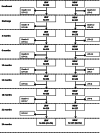Growth and neurodevelopment in low birth weight versus normal birth weight infants from birth to 24 months, born in an obstetric emergency hospital in Haiti, a prospective cohort study
- PMID: 33761917
- PMCID: PMC7988959
- DOI: 10.1186/s12887-021-02605-3
Growth and neurodevelopment in low birth weight versus normal birth weight infants from birth to 24 months, born in an obstetric emergency hospital in Haiti, a prospective cohort study
Abstract
Background: Low birthweight (LBW) infants are at higher risk of mortality and morbidity (growth, chronic disease and neurological problems) during their life. Due to the high incidence of (pre-) eclampsia in Haiti, LBW infants are common. We assessed the anthropometric growth (weight and length) and neurodevelopmental delay in LBW and normal birthweight (NBW) infants born at an obstetric emergency hospital in Port au Prince, Haiti, between 2014 and 2017.
Methods: Infants were followed at discharge and 3, 6, 12, 15, 18, 21 and 24 months of corrected gestational age. At each visit they underwent a physical checkup (weight, length, physical abnormalities, identification of morbidities). At 6, 12, 18 and 24 months they underwent a neurodevelopmental assessment using the Bayley Scale III (motor, cognitive and communication skills). We modelled the trajectories between birth and 24 months of age of NBW compared to LBW infants for weight, length, and raw scores for Bayley III assessments using mixed linear models.
Results: In total 500 LBW and 210 NBW infants were recruited of which 333 (46.7%) were followed up for 24 months (127 NBW; 60.5% and 206 LBW; 41.2%) and 150 died (LBW = 137 and NBW = 13). LBW and NBW babies gained a mean 15.8 g and 11.4 g per kg of weight from discharge per day respectively. The speed of weight gain decreased rapidly after 3 months in both groups. Both groups grow rapidly up to 6 months of age. LBW grew more than the NBW group during this period (22.8 cm vs. 21.1 cm). Both groups had WHZ scores <- 2 up to 15 months. At 24 months NBW babies scored significantly higher on the Bayley scales for gross motor, cognitive and receptive and expressive communication skills. There was no difference between the groups for fine motor skills.
Conclusion: LBW babies that survive neonatal care in urban Haiti and live up to 24 months of age, perform similar to their NBW for weight, length and fine motor skills. LBW babies are delayed in gross motor, cognitive and communication skills development. Further research on the clinical significance of these findings and long term implications of this neurodevelopmental delay is needed.
Conflict of interest statement
We declare to have no competing interests.
Figures








Similar articles
-
Low birth weight babies under village conditions: feeding pattern, growth and motor development.Paediatr Indones. 1991 Mar-Apr;31(3-4):84-98. Paediatr Indones. 1991. PMID: 1956693
-
Comparative outcome of low birth weight babies.Indian Pediatr. 1993 Jan;30(1):15-21. Indian Pediatr. 1993. PMID: 8406701
-
[Real world research on the growth pattern of preterm children with different birth weight].Zhonghua Er Ke Za Zhi. 2021 Aug 2;59(8):665-671. doi: 10.3760/cma.j.cn112140-20210204-00106. Zhonghua Er Ke Za Zhi. 2021. PMID: 34333919 Chinese.
-
Small for gestational age, term babies, in the first six years of life.Eur J Clin Nutr. 1998 Jan;52 Suppl 1:S59-64. Eur J Clin Nutr. 1998. PMID: 9511021 Review.
-
Cognitive and motor outcomes in children born low birth weight: a systematic review and meta-analysis of studies from South Asia.BMC Pediatr. 2019 Jan 29;19(1):35. doi: 10.1186/s12887-019-1408-8. BMC Pediatr. 2019. PMID: 30696415 Free PMC article.
Cited by
-
Contribution of low birth weight to childhood undernutrition in India: evidence from the national family health survey 2019-2021.BMC Public Health. 2023 Jul 12;23(1):1336. doi: 10.1186/s12889-023-16160-2. BMC Public Health. 2023. PMID: 37438769 Free PMC article.
-
Impact of Low Birth Weight on the Prevalence and Economic Burden of Common Childhood Illnesses Among Under-Five Children in India: Findings From Nationally Representative Surveys.Cureus. 2023 Jul 7;15(7):e41507. doi: 10.7759/cureus.41507. eCollection 2023 Jul. Cureus. 2023. PMID: 37551227 Free PMC article.
-
Prevalence and determinants of developmental delay among children in low- and middle-income countries: a systematic review and meta-analysis.Front Public Health. 2024 Apr 2;12:1301524. doi: 10.3389/fpubh.2024.1301524. eCollection 2024. Front Public Health. 2024. PMID: 38628845 Free PMC article.
-
Birthweight, gestational age, and early school trajectory.BMC Public Health. 2023 May 31;23(1):1032. doi: 10.1186/s12889-023-15913-3. BMC Public Health. 2023. PMID: 37259123 Free PMC article.
-
A review of the association between in vitro fertilization and children's neurocognitive development.J Assist Reprod Genet. 2025 Mar;42(3):697-706. doi: 10.1007/s10815-024-03348-7. Epub 2024 Dec 17. J Assist Reprod Genet. 2025. PMID: 39688796 Review.
References
-
- World Health Organisation. ICD-10: international statistical classification of diseases and related health problems: tenth revision, 2nd ed. World Health Organization; 2004. https://apps.who.int/iris/handle/10665/42980.
-
- World Health Organisation (WHO) and United Nations Children’s Fund (UNICEF), Wardlaw TM, World Health Organization., UNICEF., World Health Organisation (WHO) and United Nations Childrens Fund (UNICEF) Low birthweight: country, regional and global estimates. Geneva: World Health Organization; 2004.
-
- Schlaudecker EP, Munoz FM, Bardají A, Boghossian NS, Khalil A, Mousa H, et al. Small for gestational age: Case definition & guidelines for data collection, analysis, and presentation of maternal immunisation safety data. Vaccine. 2017;35:6518–6528. doi: 10.1016/j.vaccine.2017.01.040. - DOI - PMC - PubMed
MeSH terms
LinkOut - more resources
Full Text Sources
Other Literature Sources
Medical

